Sam Moskowitz’s Classics of Science Fiction
Sam Moskowitz was one of the great science fiction historians. A writer, editor, and collector extraordinaire, he was the chairman of the very first World Science Fiction Convention in New York in 1939. He was one of the first nonfiction writers to take the new field of science fiction seriously, and produced a number of anthologies and histories considered early classics today.
They’re also hard to track down, dammit. Especially his history of Science Fiction fandom, The Immortal Storm, which was printed in miniscule numbers in its original hardcover edition, and which today sells for, like, a billion dollars. It was never reprinted in paperback, unless you want to count the 1974 paperback Hyperion edition, which I didn’t even know existed until yesterday. What the hell, man. I could have saved myself a lot of collecting heartache if I’d known about this thing 20 years ago.
I discovered the Hyperion edition while I was researching Moskowitz’s Modern Masterpieces of Science Fiction, a 1965 anthology containing stories which, let’s just say, are no longer modern. But it’s still an excellent survey of early 20th Century SF, perfectly suited for a Vintage Treasures post. At least it was, until I discovered at the last minute that it was one of no less than six Moskowitz volumes published by Hyperion in 1974. So I guess I’m writing about them instead.
[Click the images for fandom-sized versions.]
The six Hyperion volumes to appear in 1974 were all reprints. They were:
Masterpieces of Science Fiction (552 pages,. $4.95) — anthology
Science Fiction by Gaslight (364 pages, $4.25) — anthology
Seekers of Tomorrow (441 pages, $5.95) — non-fiction
Modern Masterpieces of Science Fiction (518 pages, $4.95) — anthology
Explorers of the Infinite: Shapers of Science Fiction (353 pages, $3.95) — non-fiction
The Immortal Storm: A History of Science Fiction Fandom (277 pages, $3.50) — non-fiction
All six were part of Hyperion’s excellent Classics of Science Fiction series, which included novels and collections from Ray Cummings. Harold Lamb, Stanley Weinbaum, A. Merritt, Robert W. Chambers, David H. Keller, Olaf Stapledon, and many others.
How the heck did Hyperion come to publish six Sam Moskowitz volumes in a single year?
In 1974 Hyperion released 23 volumes (!) to kick off the Classics of Science Fiction line. That impressive launch was followed by a second wave of 19 additional titles in 1976. All together they make a fine foundation for a science fiction library. See the complete list at the Internet Science Fiction Database.
The series editor was Sam Moskowitz, who also provided introductions to many of the volumes. Pretty impressive for a guy who also had a day job editing a frozen food trade publication. It’s probably safe to say he didn’t get a lot of sleep in 1974 (or 1976).
In any event, Moskowitz reprinted six volumes of his own work as part of the Classics of Science Fiction series, maybe as a way to hit his numbers and save himself some rights paperwork. Whatever the case, I’m glad he did.
Not all these titles are hard to find. Science Fiction by Gaslight: A History and Anthology of Science Fiction in the Popular Magazines. 1891-1911, is a pretty easy find in hardcover, as are the paperback editions of his mini-biographies on science fiction writers, Explorers of the Infinite and Seekers of Tomorrow. But these are important books, and it’s good to have a handsome set in a durable format.
We covered another of Moskowtiz’s historical anthologies, Under the Moons of Mars: A History and Anthology of “The Scientific Romance” in the Munsey Magazines, 1912-1920, back in 2015.
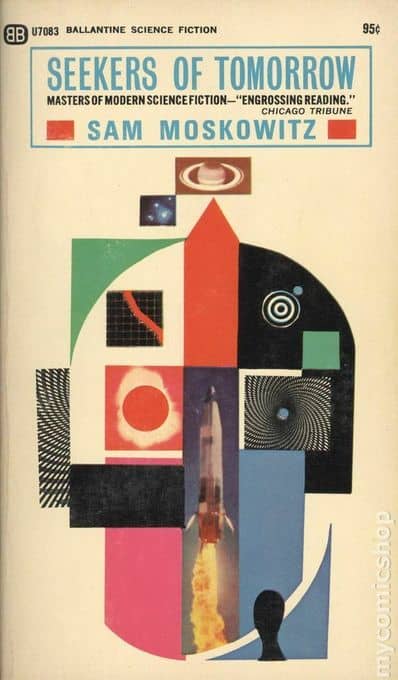 |
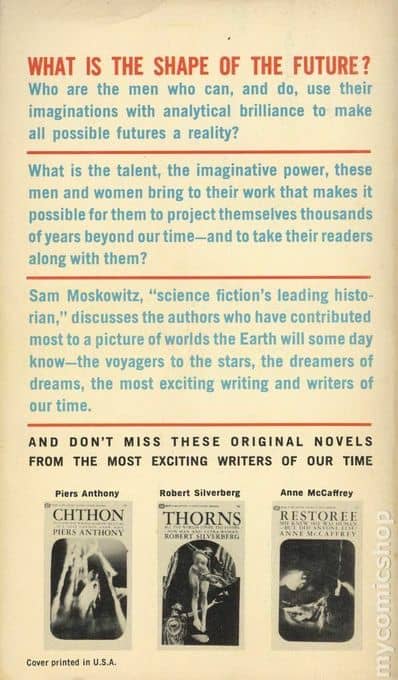 |
1967 Ballantine paperback edition of Seekers of Tomorrow
Explorers of the Infinite and Seekers of Tomorrow reprint popular articles Moskowitz wrote for science fiction magazines in the 50s and 60s. The former starts in the 17th Century with Cyrano de Bergerac and continues up through the years with Mary Shelly, Edgar Allan Poe, Jules Verne, H.G. Wells, and many others, ending in the 1930s with Stanley Weinbaum. Seekers of Tomorrow is more interesting to a modern audience (or at least, it’s more interesting to me), starting with E.E. “Doc” Smith and John W. Campbell, and covering virtually all the pre-1960 era major SF writers.
Both books (like most of the Hyperion editions, I presume) were photographic reprints of the original hardcover versions (in the case of Seekers, the 1965 World Publishing Co. edition), which saved a lot of time in layout and design, and coincidentally helps explain how they could produce 23 volumes in one year.
Here’s the Table of Contents for Seekers of Tomorrow, “a biographical and critical study of twenty-two authors widely acclaimed as the leading creators of science fiction in the last twenty-five years.” It’s a Who’s Who of major SF writers in the first half of the Century.
Introduction
1. E.E. Smith
2. John W. Campbell
3. Murray Leinster
4. Edmond Hamilton
5. Jack Williamson
6. Superman/Mort Weisinger
7. John Wyndham
8. Eric Frank Russell
9. L. Sprague de Camp
10. Lester del Rey
11. Robert A. Heinlein
12. A.E. van Vogt
13. Theodore Sturgeon
14. Isaac Asimov
15. Clifford D. Simak
16. Fritz Leiber
17. C.L. Moore
18 Henry Kuttner
19. Robert Bloch
20. Ray Bradbury
21. Arthur C. Clarke
22. Philip José Farmer
23. Starburst
How much do these books cost these days? Hard to say individually. But the pics of the four Hyperion volumes on this page are from a May eBay lot. There was only one bidder, and the whole set sold for $19.99 — quite the bargain.
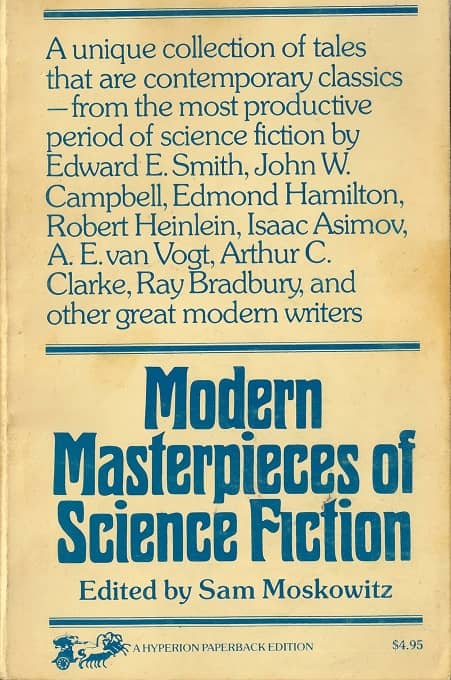 |
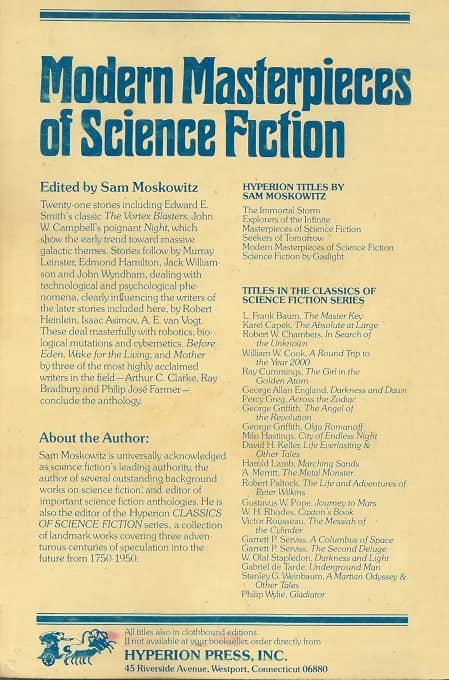 |
The only Hyperion edition I have is Modern Masterpieces of Science Fiction, which I bought last month for $5 (roughly the original cover price), and which started my investigations. It’s still the one I think most readers would be interested in reading today. Here’s the complete TOC.
Introduction by Sam Moskowitz
“The Vortex Blaster” by Edward E. Smith (1941)
“Night” by John W. Campbell, Jr. (1935)
“A Logic Named Joe” by Murray Leinster (1946)
“Requiem” by Edmond Hamilton (1962)
“With Folded Hands…” by Jack Williamson (1947)
“Adaptation” by John Wyndham (1949)
“The Witness” by Eric Frank Russell (1951)
“The Command” by L. Sprague de Camp (1938)
“Kindness” by Lester del Rey (1944)
“We Also Walk Dogs” by Robert A. Heinlein (1941)
“Enchanted Village” by A. E. van Vogt (1950)
“Liar!” by Isaac Asimov (1941)
“Microcosmic God” by Theodore Sturgeon (1941)
“Huddling Place” by Clifford D. Simak (1944)
“Coming Attraction” by Fritz Leiber (1950)
“Doorway Into Time” by C. L. Moore (1943)
“We Guard the Black Planet!” by Henry Kuttner (1942)
“The Strange Flight of Richard Clayton” by Robert Bloch (1939)
“Wake for the Living” by Ray Bradbury (1947)
“Before Eden” by Arthur C. Clarke (1961)
“Mother” by Philip José Farmer (1953)
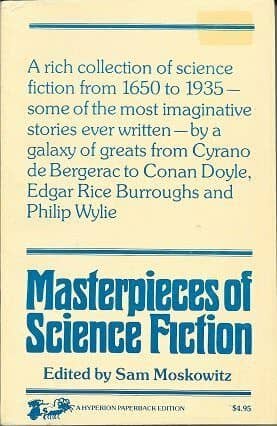 The companion volume to this book, Masterpieces of Science Fiction, was originally published by World Publishing Co. in 1967. It’s a fine anthology gathering works by many of the writers Moskowitz covered in his earlier Explorers of the Infinite (see cover at right).
The companion volume to this book, Masterpieces of Science Fiction, was originally published by World Publishing Co. in 1967. It’s a fine anthology gathering works by many of the writers Moskowitz covered in his earlier Explorers of the Infinite (see cover at right).
Our previous coverage of books by Sam Moskowitz includes:
A Sense of Wonder, edited by Sam Moskowitz
Invading Aliens and Self-Aware Submarines: The Human Zero, Edited by Sam Moskowitz & Roger Elwood, reviewed by by William I. Lengeman III
Under the Moons of Mars, edited by Sam Moskowitz
Horrors in Hiding edited by Sam Moskowitz with Alden H. Norton
Horrors Unseen, edited by Sam Moskowitz
Horrors Unknown, edited by Sam Moskowitz
See all our recent Vintage Treasures here.
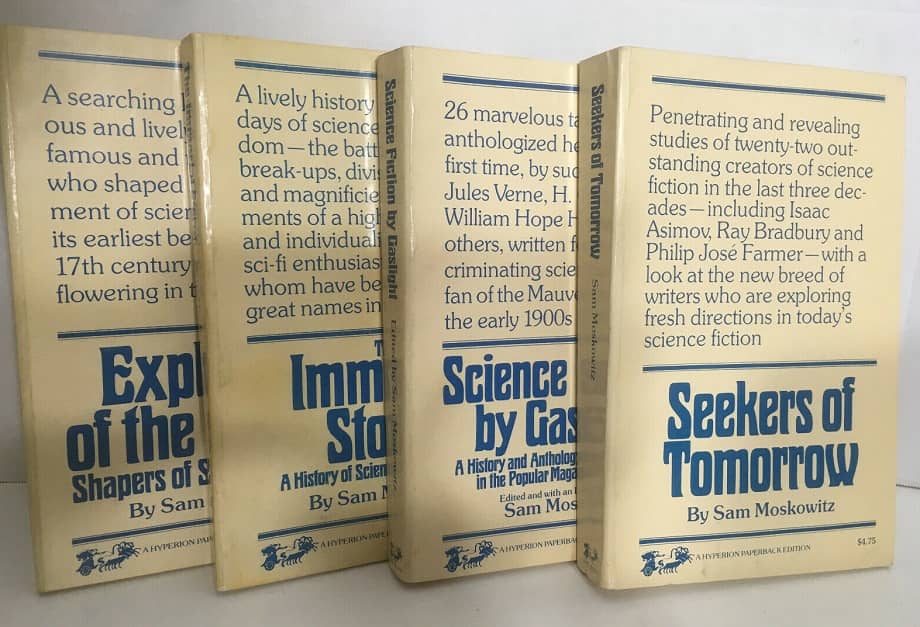
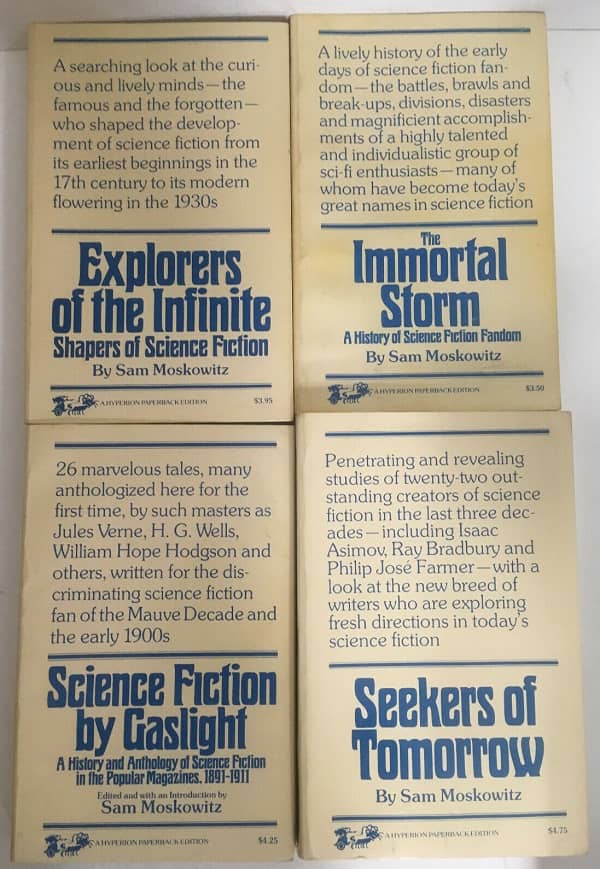
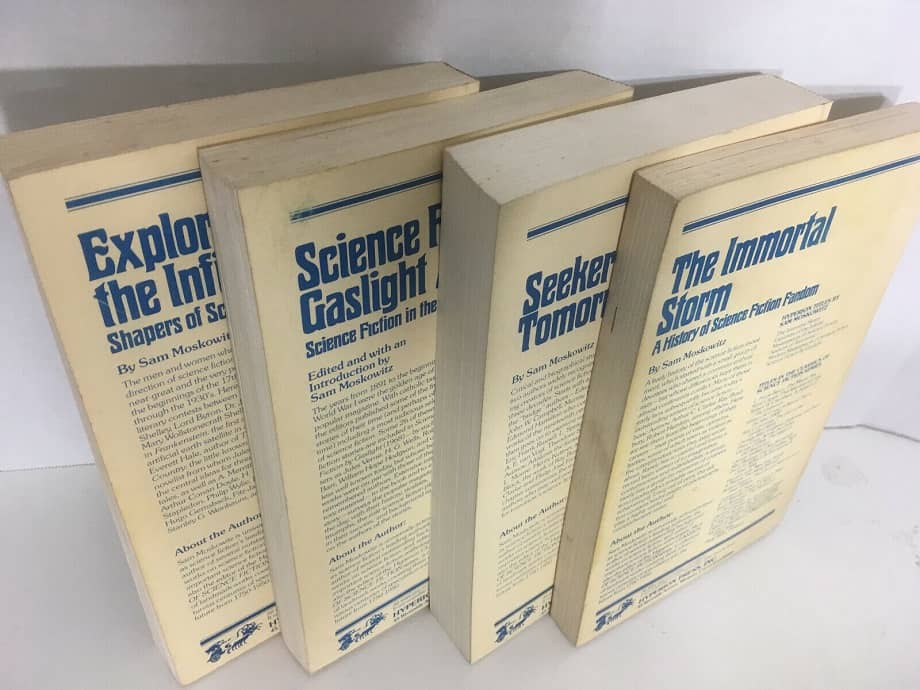
One of these days I may make a more serious effort at reading my copy of The Immortal Storm. But Harry Warner’s All Our Yesterdays and A Wealth of Fable, also on hand, look more enticing. I mean — the Shaver mystery! Claude Degler!
Apparently Moskowitz could tell a lively tale. I’m paraphrasing here, but one critic, after finishing THE IMMORTAL STORM, thought that World War 2 seemed almost anti-climatic.
I have that 1967 edition of Seekers of Tomorrow, but it’s been a long time since I read it.
Moskowitz as a Great Historian or a Great Editor is at least three errors in one sentence, alas. His prose is clunky, at its best, his desire to recast the recent and more distant past to fit his desires was more pronounced than at least the majority of those who’ve also produced fan and publishing histories, and his taste as an editor, while a matter of taste, is usually very off-point compared to nearly all his contemporaries. Even for his favorite era, the Gernsback early years, the likes of Paul A. Carter is a more reliable guide. So, let the reader as well as collector beware.
FWIW, it looks like NESFA Press is selling an eBook of The Immortal Storm, although I think you have to get it directly from their website.
What are the notable fan historical books? We have Moskowitz’s Immortal Storm; Warner’s All Our Yesterdays and A Wealth of Fable — these cover 1930s-1950s.
There are several memoirs: Damon Knight’s The Futurians; Pohl’s The Way the Future Was; Clarke’s Astounding Days.
Gary Hunnewell/Hildifons Took has published several reviews of Tolkien fanzines, but these are bibliographic works from, roughly, the 1950s to 1967 or 1968.
http://efanzines.com/TFR/TolkienFandom2ndEd.pdf
There’s Rob Hansen’s Then: SF Fandom in the UK 1930-1980. And Peter Weston’s With Stars in My Eyes: My Adventures in British Fandom (not seen by me).
The fanzine Mimosa goes into fannish history.
There are various collections of fannish writing, but I’m asking specifically about histories.
Dale Nelson
Also a memoir is Lloyd Arthur Eshbach’s Over My Shoulder: Reflections on a Science Fiction Era — with a particular focus on fannish presses such as Gnome, Arkham, FPCI, etc.
And there’s the online “wiki”-type reference source, Fancyclopedia 3.
http://fancyclopedia.org/fancyclopedia-3
But as far as I know, no one has written a book like Moskowitz’s or Warner’s about the decade of the 1960s or the subsequent decades. It would be interesting to have books on the 1960s and 1970s, which were breakthrough decades for our genres, given phenomena such as the enormous popularity of The Lord of the Rings in paperback, sword and sorcery, the Ballantine Adult Fantasy Series, the financial success of several sf movies, so that by the end of the 1970s Hollywood is pretty deeply invested in the genre, and so on.
I personally am most interested in Tolkien and Inklings fandom, hence in the Tolkien Society (English), the Tolkien Society of America, the Mythopoeic Society, and various less-known activities and the associated fanzines.
> One of these days I may make a more serious effort at reading my copy of The Immortal Storm.
> But Harry Warner’s All Our Yesterdays and A Wealth of Fable, also on hand, look more enticing.
Dale,
Confession time — I’d never heard of Warner’s All Our Yesterdays until you mentioned it. But it looks like something I’d really enjoy. This is what Wikipedia says about it:
“All Our Yesterdays by Harry Warner, Jr., is a history of science fiction fandom of the 1940s, an essential reference work in the field. It was originally published by Advent in 1969; the members of the World Science Fiction Society voted its author the Hugo Award for Best Fan Writer that year. NESFA Press produced a new edition with additional photographs, in 2004, after Warner’s death.”
New copies are available on Amazon for $25… I’ve already added it to my cart. Thanks for the tip!
> one critic, after finishing THE IMMORTAL STORM, thought that World War 2 seemed almost anti-climatic.
Sven,
I’ve read that too… although I thought it was a reference to how hyperbolic Moskowitz was; that a stranger reading both couldn’t tell which was the more dire conflict. 🙂
> Moskowitz as a Great Historian or a Great Editor is at least three errors in one
> sentence, alas. His prose is clunky, at its best, his desire to recast the recent and
> more distant past to fit his desires was more pronounced than at least the majority…
Todd,
Oh, fair enough. There’s a reason Moskowitz’s books have not been reprinted in several decades; they’ve been supplanted by better written and more objective works.
Still, I consider Moskowtiz an important part of the history of the genre. Yes, his efforts were often more fannish than pro. But he was one of the very first to write seriously about SF at all, and I have no doubt his efforts inspired others. Isaac Asimov dedicated Before the Golden Age to him. I still believe he was instrumental in the movement to preserve both science fiction, and its fannish history.
> FWIW, it looks like NESFA Press is selling an eBook of The Immortal Storm
Joe — so they are. For just $5.95!
https://www.nesfa.org/book/the-immortal-storm/
Thanks for the tip!
> What are the notable fan historical books? We have Moskowitz’s Immortal Storm;
> Warner’s All Our Yesterdays and A Wealth of Fable — these cover 1930s-1950s.
There are several memoirs: Damon Knight’s The Futurians; Pohl’s The Way the Future Was;
> Clarke’s Astounding Days.
Dale,
That’s a great list! The only one I can think to add is Lester del Rey’s The World of Science Fiction 1926-1976: The History of a Subculture, published by Del Rey / Ballantine in 1979. (Click the images below to get versions with legible text.)
It’s a decent little historical study.
I’m sure I’m missing more than a few. Any other suggestions?
IN AND OUT OF QUANDRY by Lee Hoffman comes to mind, published (also by NESFA) as a double with A. Bertram Chandler’s UP TO THE SKY IN SHIPS as a convention item. Not the only relevant NESFA volume thus.
A Lot of occasional writing and partial focus of various memoirs, both book-length and as introductions to collections and the like.
Items of some relevance that might be seen as Mostly not quite fannish history, but useful:
IN MEMORY YET GREEN, In JOY STIL FELT, and I. ASIMOV (and his letters, and short memoirs such as those in BEFORE THE GOLDEN AGE and SCIENCE, NUMBERS AND I by Isaac Asimov
YESTERDAY’S TOMORROWS (mostly an account of his editorial career, wrapped around fiction he edited one way or another, but…) by Frederik Pohl
HELL’S CARTOGRAPHERS edited by Harry Harrison and Brian Aldiss–memoirs by Robert Silverberg, Alfred Bester, Frederik Pohl, Damon Knight and the editors, all of who have since written book-length memoirs in one form or another, with the exception of Bester, who revised his essay slightly for both Harrison’s original anthology NOVA 4 and inclusion in Bester’s collection STARLIGHT.
BETTER TO HAVE LOVED, edited from the rough draft of Judith Merril’s memoirs.
ONCE AROUND THE BLOCH by Robert Bloch
Some of the content of any number of Harlan Ellison’s collections.
PITFCS: The Proceedings of the Institute for Twenty-First Century Studies, the nearly complete reprint edition of the “fanzine for pros” of the early ’60s, in boards from Advent/NESFA.
Meanth to add THE MOTION OF LIGHT IN WATER by Samuel Delany…but, then, meant to capitalize IN in IN JOY STILL FELT byt Asimov, too.
Yes. the typos are definitely too much in evidence. A correction function would be welcome!
Also relevant to the (early) ’60s:
THE BEST OF XERO edited by Pat and Dick Lupoff
also, their collaborator Bhob Stewart’s blog, POTRZEBIE:
http://potrzebie.blogspot.com/
THE EIGHTH STAGE OF FANDOM by Robert Bloch
See also the Trans-Atantic Fan Fund (TAFF) Free eBook series:
https://taff.org.uk/ebooks.php
Nice bibliography of fan histories is developing here — thanks.
But I’m not seeing that wished-for history of fandom in the 1960s. Really, it doesn’t exist?
What a decade that was. For some, that was an exciting decade because of the New Wave; for others, it was a great decade because of the mass market reprinting of so much old-fashioned fun — think of those Ace and Ballantine reprints of Edgar Rice Burroughs, the Edmond Hamilton Captain Future books, and so on. That was the decade of 2001: A Space Odyssey, The Outer Limits, and Star Trek — and, of course, in the real world, of the first men on the moon. Swarming around all of these were the fanzines, some of which had a near-professional appearance. Some very long-lived ones were founded in that decade, e.g. Locus. Fan press activity included the founding of Mirage Press, etc. My guess is that this was the decade in which fannish products such as the small press books etc. began to show up pretty widely in college-town bookstores, etc., though I don’t know if that’s the case — but there was much demand, e.g., for Tolkien-related material. The first Tolkien conventions were in the late 1960s.
So there would be plenty to write about in a fannish history of the 1960s.
Dale Nelson
1. John, in retrospect, you’re probably right.
2. I found both the Knight and Pohl memoirs to be quite entertaining. But as I grow older and a bit more cynical, I wonder how accurate and truthful those books really were. Time and ego effects even sf greats.
3. I’m just making a guess here, but was 60’s science fiction fandom larger and more diffused than in the 40’s and 50’s? Perhaps the size of it discouraged a veteran chronicler like Warner from giving it a go.
Stray thoughts…
Look particularly to the TAFF texts (particularly the Terry Carr items and such), and for the early ’60s, PTIFCS, the Lee Hoffman and the XERO book. You’d do well to read the MIMOSA back file for some sense of the ’60s and later fandom as well. Harry Warner wrote about what he knew about…the calving of fandoms out of SF fandom had definitely begun in earnest by the turn of the ‘sixties, with folk fanzines and rock fanzines (some turning pro, such as when Lee Hoffman sold CARAVAN to pros and Paul Williams professionalized CRAWDADDY! in the ’60s) joining comics fanzines and the like…the punk fanzines, via Greg Shaw’s WHO PUT THE BOMP, would come later, as would the media sf fanazines…http://www.jophan.org/mimosa/
So, I’m not aware of a single book-length attempt to write a fannish history of the ’60s in the US. THEN does tackle that decade among others for UK fandom.
Since I’m late to the game, Dale, why the “Major Wootton” sig?
Sven–The Pohl is very diplomatic, and somewhat self-protective. The Knight strives to Tell All Entertainingly. Those caveats taken in mind, I don’t find either of them as full as History The Way I Want It To Be as in, say, Moskowitz. There are indeed limits to autobiography as The Complete and Final Truth about anything, just as there are the same limits with anything else.
Todd,
I’m really appreciating your comments, especially your attempt to itemize the better fan histories.
It occurs to me that this subject is more than worthy of a follow-up post, and your list above is a most excellent start. In fact, just editing your comments here into something a little more ordered would make a very worthwhile post.
Would you be wiling to let me do that? Or would you like to take a stab at something more organized? Just based on the volume of comments here, and I think readers would really appreciate it.
Yes please, to a full post from Todd Mason about Sixties the fannish scene.
“Major Wotton” was just a nom-de-net I took on many years ago, alluding to Tolkien’s S,ith of Wootton Major.
Dale Nelson